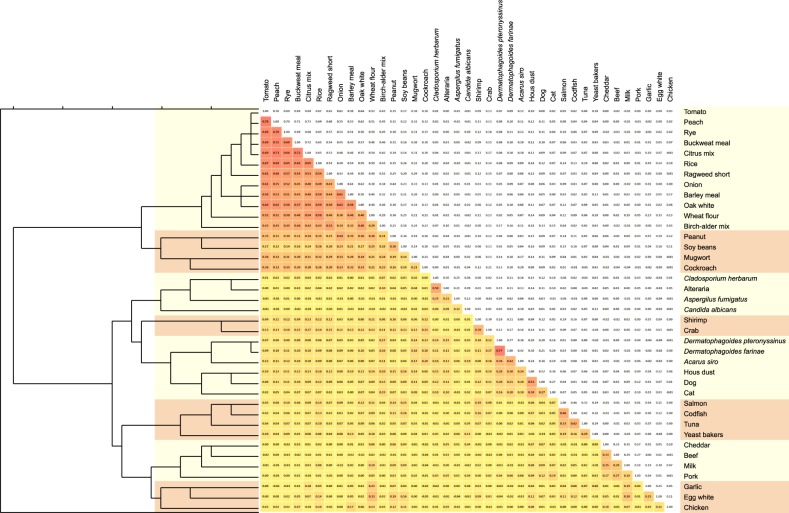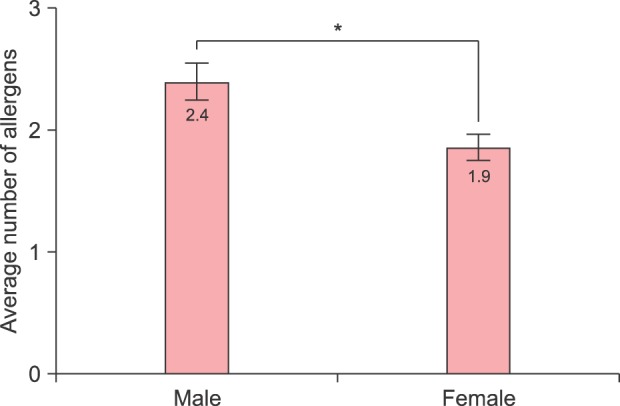Ann Dermatol.
2017 Dec;29(6):735-741. 10.5021/ad.2017.29.6.735.
Allergen Sensitization Pattern by Sex: A Cluster Analysis in Korea
- Affiliations
-
- 1Department of Dermatology, Seoul Metropolitan Government Seoul National University Boramae Medical Center, Seoul, Korea. sycho@snu.ac.kr
- KMID: 2395181
- DOI: http://doi.org/10.5021/ad.2017.29.6.735
Abstract
- BACKGROUND
Allergens tend to sensitize simultaneously. Etiology of this phenomenon has been suggested to be allergen cross-reactivity or concurrent exposure. However, little is known about specific allergen sensitization patterns.
OBJECTIVE
To investigate the allergen sensitization characteristics according to gender.
METHODS
Multiple allergen simultaneous test (MAST) is widely used as a screening tool for detecting allergen sensitization in dermatologic clinics. We retrospectively reviewed the medical records of patients with MAST results between 2008 and 2014 in our Department of Dermatology. A cluster analysis was performed to elucidate the allergen-specific immunoglobulin (Ig)E cluster pattern.
RESULTS
The results of MAST (39 allergen-specific IgEs) from 4,360 cases were analyzed. By cluster analysis, 39items were grouped into 8 clusters. Each cluster had characteristic features. When compared with female, the male group tended to be sensitized more frequently to all tested allergens, except for fungus allergens cluster.
CONCLUSION
The cluster and comparative analysis results demonstrate that the allergen sensitization is clustered, manifesting allergen similarity or co-exposure. Only the fungus cluster allergens tend to sensitize female group more frequently than male group.
Keyword
MeSH Terms
Figure
Cited by 1 articles
-
Efficacy and Safety of Sublingual Immunotherapy in Elderly Rhinitis Patients Sensitized to House Dust Mites
Ji Hye Kim, Ji Ho Lee, Young-Min Ye, Jae-Hyun Lee, Jung Won Park, Gyu-Young Hur, Joo-Hee Kim, Hyn-Young Lee, Yoo Seob Shin, Eun-Mi Yang, Hae-Sim Park
Allergy Asthma Immunol Res. 2018;10(6):675-685. doi: 10.4168/aair.2018.10.6.675.
Reference
-
1. Salo PM, Arbes SJ Jr, Jaramillo R, Calatroni A, Weir CH, Sever ML, et al. Prevalence of allergic sensitization in the United States: results from the National Health and Nutrition Examination Survey (NHANES) 2005-2006. J Allergy Clin Immunol. 2014; 134:350–359. PMID: 24522093.
Article2. Amaral AFS, Newson RB, Abramson MJ, Antó JM, Bono R, Corsico AG, et al. Changes in IgE sensitization and total IgE levels over 20 years of follow-up. J Allergy Clin Immunol. 2016; 137:1788–1795.e9. PMID: 26586040.3. Warm K, Backman H, Lindberg A, Lundbäck B, Rönmark E. Low incidence and high remission of allergic sensitization among adults. J Allergy Clin Immunol. 2012; 129:136–142. PMID: 21975174.
Article4. Scala E, Alessandri C, Bernardi ML, Ferrara R, Palazzo P, Pomponi D, et al. Cross-sectional survey on immunoglobulin E reactivity in 23,077 subjects using an allergenic molecule-based microarray detection system. Clin Exp Allergy. 2010; 40:911–921. PMID: 20214663.
Article5. Soeria-Atmadja D, Onell A, Kober A, Matsson P, Gustafsson MG, Hammerling U. Multivariate statistical analysis of large-scale IgE antibody measurements reveals allergen extract relationships in sensitized individuals. J Allergy Clin Immunol. 2007; 120:1433–1440. PMID: 17825892.
Article6. García BE, Lizaso MT. Cross-reactivity syndromes in food allergy. J Investig Allergol Clin Immunol. 2011; 21:162–170. quiz 2 p following 170.7. Ferreira F, Hawranek T, Gruber P, Wopfner N, Mari A. Allergic cross-reactivity: from gene to the clinic. Allergy. 2004; 59:243–267. PMID: 14982506.
Article8. van Ree R, Voitenko V, van Leeuwen WA, Aalberse RC. Profilin is a cross-reactive allergen in pollen and vegetable foods. Int Arch Allergy Immunol. 1992; 98:97–104. PMID: 1643445.
Article9. Beardslee TA, Zeece MG, Sarath G, Markwell JP. Soybean glycinin G1 acidic chain shares IgE epitopes with peanut allergen Ara h 3. Int Arch Allergy Immunol. 2000; 123:299–307. PMID: 11146387.
Article10. Ballabio C, Magni C, Restani P, Mottini M, Fiocchi A, Tedeschi G, et al. IgE-mediated cross-reactivity among leguminous seed proteins in peanut allergic children. Plant Foods Hum Nutr. 2010; 65:396–402. PMID: 21080075.
Article11. Ma S, Nie L, Li H, Wang R, Yin J. Component-resolved diagnosis of peanut allergy and its possible origins of sensitization in China. Int Arch Allergy Immunol. 2016; 169:241–248. PMID: 27240834.
Article12. Woo CK, Bahna SL. Not all shellfish “allergy” is allergy! Clin Transl Allergy. 2011; 1:3. PMID: 22410209.
Article13. Tee RD, Gordon DJ, Taylor AJ. Cross-reactivity between antigens of fungal extracts studied by RAST inhibition and immunoblot technique. J Allergy Clin Immunol. 1987; 79:627–633. PMID: 3549841.
Article14. Breitenbach M, Simon-Nobbe B. The allergens of Cladosporium herbarum and Alternaria alternata. Chem Immunol. 2002; 81:48–72. PMID: 12102004.
Article15. Daul CB, Slattery M, Reese G, Lehrer SB. Identification of the major brown shrimp (Penaeus aztecus) allergen as the muscle protein tropomyosin. Int Arch Allergy Immunol. 1994; 105:49–55. PMID: 7916224.16. Leung PS, Chen YC, Gershwin ME, Wong SH, Kwan HS, Chu KH. Identification and molecular characterization of Charybdis feriatus tropomyosin, the major crab allergen. J Allergy Clin Immunol. 1998; 102:847–852. PMID: 9819304.
Article17. Wong L, Huang CH, Lee BW. Shellfish and house dust mite allergies: is the link tropomyosin? Allergy Asthma Immunol Res. 2016; 8:101–106. PMID: 26739402.
Article18. Saridomichelakis MN, Marsella R, Lee KW, Esch RE, Farmaki R, Koutinas AF. Assessment of cross-reactivity among five species of house dust and storage mites. Vet Dermatol. 2008; 19:67–76. PMID: 18336423.
Article19. Spitzauer S, Pandjaitan B, Mühl S, Ebner C, Kraft D, Valenta R, et al. Major cat and dog allergens share IgE epitopes. J Allergy Clin Immunol. 1997; 99:100–106. PMID: 9003217.
Article20. Cabañas R, López-Serrano MC, Carreira J, Ventas P, Polo F, Caballero MT, et al. Importance of albumin in cross-reactivity among cat, dog and horse allergens. J Investig Allergol Clin Immunol. 2000; 10:71–77.21. Poulsen LK, Hansen TK, Nørgaard A, Vestergaard H, Stahl Skov P, Bindslev-Jensen C. Allergens from fish and egg. Allergy. 2001; 56(Suppl 67):39–42. PMID: 11298006.
Article22. Swoboda I, Bugajska-Schretter A, Verdino P, Keller W, Sperr WR, Valent P, et al. Recombinant carp parvalbumin, the major cross-reactive fish allergen: a tool for diagnosis and therapy of fish allergy. J Immunol. 2002; 168:4576–4584. PMID: 11971005.
Article23. Werfel SJ, Cooke SK, Sampson HA. Clinical reactivity to beef in children allergic to cow's milk. J Allergy Clin Immunol. 1997; 99:293–300. PMID: 9058683.24. Martelli A, De Chiara A, Corvo M, Restani P, Fiocchi A. Beef allergy in children with cow's milk allergy; cow's milk allergy in children with beef allergy. Ann Allergy Asthma Immunol. 2002; 89(6 Suppl 1):38–43.
Article25. Commins SP, Satinover SM, Hosen J, Mozena J, Borish L, Lewis BD, et al. Delayed anaphylaxis, angioedema, or urticaria after consumption of red meat in patients with IgE antibodies specific for galactose-alpha-1,3-galactose. J Allergy Clin Immunol. 2009; 123:426–433. PMID: 19070355.26. Szépfalusi Z, Ebner C, Pandjaitan R, Orlicek F, Scheiner O, Boltz-Nitulescu G, et al. Egg yolk alpha-livetin (chicken serum albumin) is a cross-reactive allergen in the bird-egg syndrome. J Allergy Clin Immunol. 1994; 93:932–942. PMID: 8182236.27. Kao SH, Hsu CH, Su SN, Hor WT, Chang T WH, Chow LP. Identification and immunologic characterization of an allergen, alliin lyase, from garlic (Allium sativum). J Allergy Clin Immunol. 2004; 113:161–168. PMID: 14713923.
Article28. Nickel R, Illi S, Lau S, Sommerfeld C, Bergmann R, Kamin W, et al. Variability of total serum immunoglobulin E levels from birth to the age of 10 years. A prospective evaluation in a large birth cohort (German Multicenter Allergy Study). Clin Exp Allergy. 2005; 35:619–623. PMID: 15898984.
Article29. Court CS, Cook DG, Strachan DP. The descriptive epidemiology of house dust mite-specific and total immunoglobin E in England using a nationally representative sample. Clin Exp Allergy. 2002; 32:1033–1041. PMID: 12100050.30. Böhme M, Svensson A, Kull I, Nordvall SL, Wahlgren CF. Clinical features of atopic dermatitis at two years of age: a prospective, population-based case-control study. Acta Derm Venereol. 2001; 81:193–197. PMID: 11558876.31. Criqui MH, Seibles JA, Hamburger RN, Coughlin SS, Gabriel S. Epidemiology of immunoglobulin E levels in a defined population. Ann Allergy. 1990; 64:308–313. PMID: 2310062.32. Barbee RA, Halonen M, Lebowitz M, Burrows B. Distribution of IgE in a community population sample: correlations with age, sex, and allergen skin test reactivity. J Allergy Clin Immunol. 1981; 68:106–111. PMID: 7251998.
Article33. Wouters IM, Douwes J, Doekes G, Thorne PS, Brunekreef B, Heederik DJ. Increased levels of markers of microbial exposure in homes with indoor storage of organic household waste. Appl Environ Microbiol. 2000; 66:627–631. PMID: 10653727.
Article34. Husman T. Health effects of indoor-air microorganisms. Scand J Work Environ Health. 1996; 22:5–13.
Article35. Park DS, Cho JH, Lee KE, Ko S, Kim HR, Choi SI, et al. Detection rate of allergen-specific IgE by multiple antigen simultaneous test-immunoblot assay. Korean J Lab Med. 2004; 24:131–138.
- Full Text Links
- Actions
-
Cited
- CITED
-
- Close
- Share
- Similar articles
-
- Cluster Analysis of Inhalant Allergens in South Korea: A Computational Model of Allergic Sensitization
- Prevalence Rate of Sensitization to Cat Allergen in Children with Nasal Symptoms in Kunpo city
- Allergen sensitization trajectories in children with respiratory and allergic diseases
- Change of Inhalant Allergen Sensitization in Children with Allergic Respiratory Diseases during Recent 10 Years
- Changes in allergen sensitization in children with allergic diseases in the 1980 to 2019



